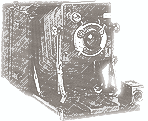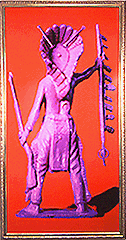 |
||||||||||||
|
Emergence from the Shadow: First Peoples' Photographic Perspectives was presented from 22 October 1999 until 6 January 2002 in the art gallery of the First Peoples Hall of the Canadian Museum of Civilization. Popular culture — from cigar store icons to television and the Hollywood western — has played a major role in creating and ingraining stereotypical images of the North American Indian. Emerging from the shadow cast by this popularized notion of Indian life, this exhibition's two perspectives on First Peoples explore themes of community and continuity, and how the past influences the present in both cultural and artistic terms. The first perspective — Through the Anthropologist's Camera — examines the work of four anthropologists who studied First Peoples for the Geological Survey of Canada (now the Canadian Museum of Civilization) during the early twentieth century. Culled from thousands of fieldwork photographs in the Canadian Museum of Civilization's archives, this astonishing record represents a new genre called "fieldwork portraiture". Demonstrating the control First Peoples often exerted over the photographic process, these images bear witness to the sitters' vanishing world — left as a gift to future generations. The second facet of the exhibition — Perspectives from the Urban Frontier — showcases the work of six contemporary First Peoples artists. Their various photo-based works speak to self-determination, to the reality of today's urban First Peoples, and to the deep bond that exists between modern First Peoples and their ancestors. Jeffrey M. Thomas, guest curator Through the Anthropologist's Camera Anthropologists in the field often used photography as part of their documentary process, and the Canadian Museum of Civilization's archives include many thousands of photographs recording various aspects of First Peoples life. These include numerous photographs of individuals — a photographic genre which has since been dubbed "fieldwork portraiture". Notably absent from the photographs taken by the anthropologists profiled in this exhibition were stereotypical images of feather headdresses, painted faces, and bows and arrows. The intimacy of the bond between photographer and sitter quickly becomes apparent in this selection of photographs. More than a simple anthropological record, the photographs provide a window to the past, enabling us to become better acquainted with the living and breathing people they portray. Through this photographic record, the sitters have, in effect, ensured that evidence of their world would be guarded for future discovery by their descendants. Perspectives from the Urban Frontier In 1983, the Native American Photographers Show, held in Oklahoma, brought together First Peoples artists from across North America. The show not only heralded a new vision of North American First Peoples, but also made it clear that there were large numbers of aboriginal photographic artists at work across the continent. The contemporary works featured in Emergence from the Shadow reflect the legacy of early photographic experimentation in the 1980s. Artists like Shelley Niro and Greg Staats were part of this first wave of aboriginal contemporary photographers, and their artistic vision laid the groundwork for a new and critical response to a history that had included the faces of First Peoples, but not their voices. Historically, popular photographic interest in First Peoples' culture focused on the sublime "Indian warrior," — a free-roaming, pre-reserve figure. Commercial photographers also left out the less picturesque aspects of reserve and urban First Peoples life, in favour of the romanticized "Indian warrior" postcard approach. By contrast, contemporary artists like Mary Anne Barkhouse, Rosalie Favell, Barry Ace and Greg Hill confront the urban realities of today's First Peoples. Rather than perpetuating imagery from the past, they address complex contemporary social issues through their creation of photographic works of art. |
|||||||||||

